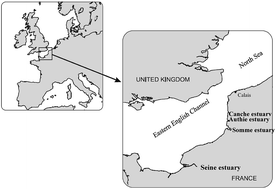Metal concentrations, growth and condition indices in European juvenile flounder (Platichthys flesus) relative to sediment contamination levels in four Eastern English Channel estuaries
Abstract
The aim of the present study was to evaluate the effects of metal contamination on the biological responses of 0-group juvenile European flounder and to assess and compare the quality of four estuarine habitats located in the Eastern English Channel. Fish otolith growth and condition indices (RNA : DNA ratio, Fulton's K condition index) were measured and found to be significantly lower in individuals from the Seine estuary compared to those of the Canche, Authie and Somme estuaries. No obvious effects of hydrological condition or food availability on the flounder biological responses were observed. Sediments from the Seine showed the highest metal concentrations, bioavailable proportion and enrichment factors. Higher metal concentrations were observed in fish from the Seine compared to the other ones caught in less polluted estuaries. These results suggest that contaminants may have a negative impact on the early life history stage of flounder.


 Please wait while we load your content...
Please wait while we load your content...